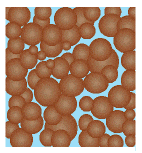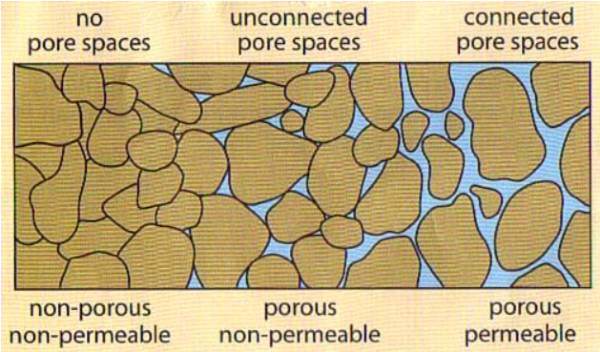6 Major Difference Between Porosity and Permeability
Compiled by Stanley Udegbunam || Dec 03, 2020
AFRILCATE
OVERVIEW OF POROSITY AND PERMEABILITY
Porosity and Permeability are two closely related terms to the extent that they are often confused for the other.
A clear difference exists between them therefore it is a wrong practice to use both terms interchangeably.
We will look at the disparities between both terms starting from their definitions and we will conclude with a tabular representation of the differences.
Let’s begin…
WHAT IS POROSITY?
Porosity refers to the amount of empty space within a given material.
These empty spaces are called pores and since they are void, the materials exhibits water holding capacity.
Therefore, we can define “rock porosity” (porosity of rock) as a measure of the ability of the given rock sample to hold fluid within its pore space.
This space can be between grains, cracks or within the cavity of rocks.
Deductively, we can also define porosity as the volume of empty spaces or pores relative to the total rock volume.
Porosity = (Volume of pore spaces / total rock volume) × 100%
It can be expressed as a percentage.
For most rocks, porosity varies from less than 1% to 40%.
Porosity is dependent upon factors like the size, shape, and aggregate packing of soil particles.
It’s also a good measure of the water holding capacity of the soil.
WHAT IS PERMEABILITY?
Permeability is a measure of the ease with which a fluid can move through porous rock. It refers to how connected pore spaces are to one another.
If the material has high permeability then the pore spaces are well connected allowing water to completely flow through.
However, if there is low permeability then the pore spaces are isolated and the water is trapped.
A rock may be extremely porous, but if the pores are not connected to one another, it will have no permeability.
Likewise, a rock may have just tiny pore openings indicating low porosity but if they are well connected, the rock becomes highly permeable despite their low porosity.
Rocks such as pumice and shale have high porosity, yet they are nearly impermeable (poorly interconnected voids).
Clay is also porous but it’s the least permeable due to its compact nature.
This explains why clay is usually referred to as an aquitard.
Aquitards are poorly permeable geologic formations that retard the flow of groundwater.

Permeability – connected pore spaces
Some materials like gravel and sand are both porous and permeable, making them good aquifer materials.
If the soil is both permeable and porous, infiltration rate is increased and percolation to the water table is hastened.
Permeability is typically expressed in Darcy (d) and millidarcy (md)

TABULAR DIFFERENCE BETWEEN POROSITY AND PERMEABILITY
The table below groups the differences into key sections for easy understanding.
| Differences | POROSITY | PERMEABILITY |
|---|---|---|
| DEFINITION | A measure of the void space in a given material. | A measure of the ease with which a fluid can move through a porous material. |
| MEASURING INSTRUMENT | Can be measured using the Bendtsen Roughness / Smoothness Tester | Measured using Insitu borehole permeability testing or cone penetration tests. |
| SYMBOL | Denoted with the Greek symbol (∅). | Denoted with the letter (K). |
| EXAMPLE | Pumice is an extremely porous volcanic rock. Others include: limestone and dolomite. | Sandstone, fractured igneous and metamorphic rocks. |
| Factors | Dependent on grain size, shape and material composition. | Dependent on grain size, pore fluid properties, void ratio, organic matter and adsorbed water. |
| UNIT | Expressed as a percentage (%) | Expressed in Darcy(d) and millidarcy (md) |
| Differences | POROSITY | PERMEABILITY |
|---|---|---|
| DEFINITION | Amount of the void space in a given material. | The ease with which a fluid can move through a porous material. |
| MEASURING INSTRUMENT | Can be measured using the Bendtsen Roughness / Smoothness Tester | Measured using Insitu borehole permeability testing or cone penetration tests. |
| SYMBOL | Denoted with the Greek symbol (∅). | Denoted with the letter (K). |
| EXAMPLE | Pumice is an extremely porous volcanic rock. Others include: limestone and dolomite. | Sandstone, fractured igneous and metamorphic rocks. |
| Factors | Dependent on grain size, shape and material composition. | Dependent on grain size, pore fluid properties, void ratio, organic matter and adsorbed water. |
| UNIT | Expressed as a percentage (%) | Expressed in Darcy(d) and millidarcy (md) |
Despite the differences, porosity and permeability are both intrinsic properties of geologic materials.
DO YOU KNOW?
The study of the occurrence, distribution, movement and properties of water
on and beneath the earth surface is called hydrology.
DO YOU KNOW?
The study of the occurrence, distribution, movement and properties of water on and beneath the earth surface is called hydrology.

